Beginning with early film adaptations of 19th-century novels to a present-day small-screen resurgence, the subgenre has proved to have serious staying power.
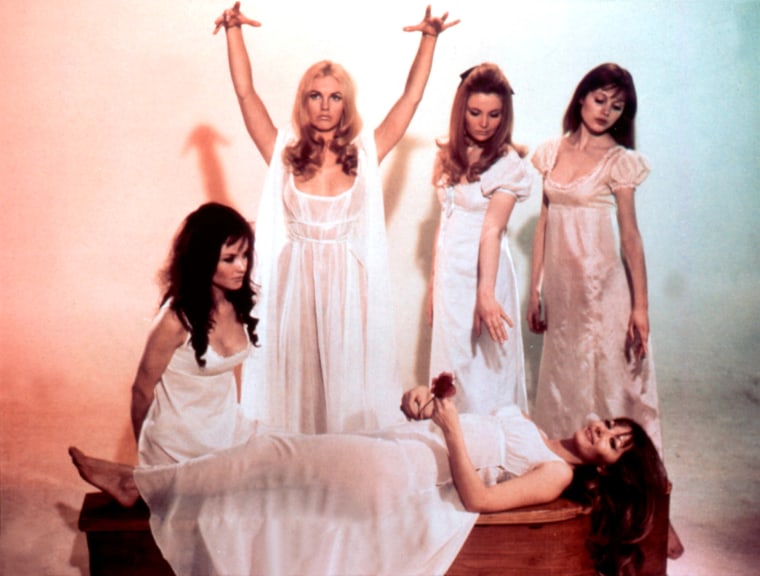
Kate O'Mara, Kirsten Betts, Pippa Steel, Madeline Smith and Ingrid Pitt Valo
in "The Vampire Lovers."Moviestore Collection Ltd / Alamy Stock Photo
Oct. 30, 2021
By Elaina Patton
Sexual fluidity has been one of the hallmarks of vampiric portrayals throughout history. But lesbian vampires, in particular, have enjoyed a certain popularity. Beginning with early film adaptations of 19th-century novels to a present-day small-screen resurgence, the subgenre has proved to have serious staying power.
"I think part of it is just the appeal of vampires in general," said lesbian romance novelist Evelyn Dar, who runs a popular YouTube channel dedicated to lesbian entertainment. "They’re mysterious and dark. It’s taboo and sexy."
That appeal, however, was a double-edged sword for lesbian representation. For decades, and particularly during the subgenre’s heyday of the 1960s and ‘70s, vampire narratives were a dominant means of getting lesbianism on-screen. And the associations between sapphic love and bloodthirsty villains stuck.
“They were evil. They were sexually deviant. They almost always had to die,” Dar said of those popular depictions.
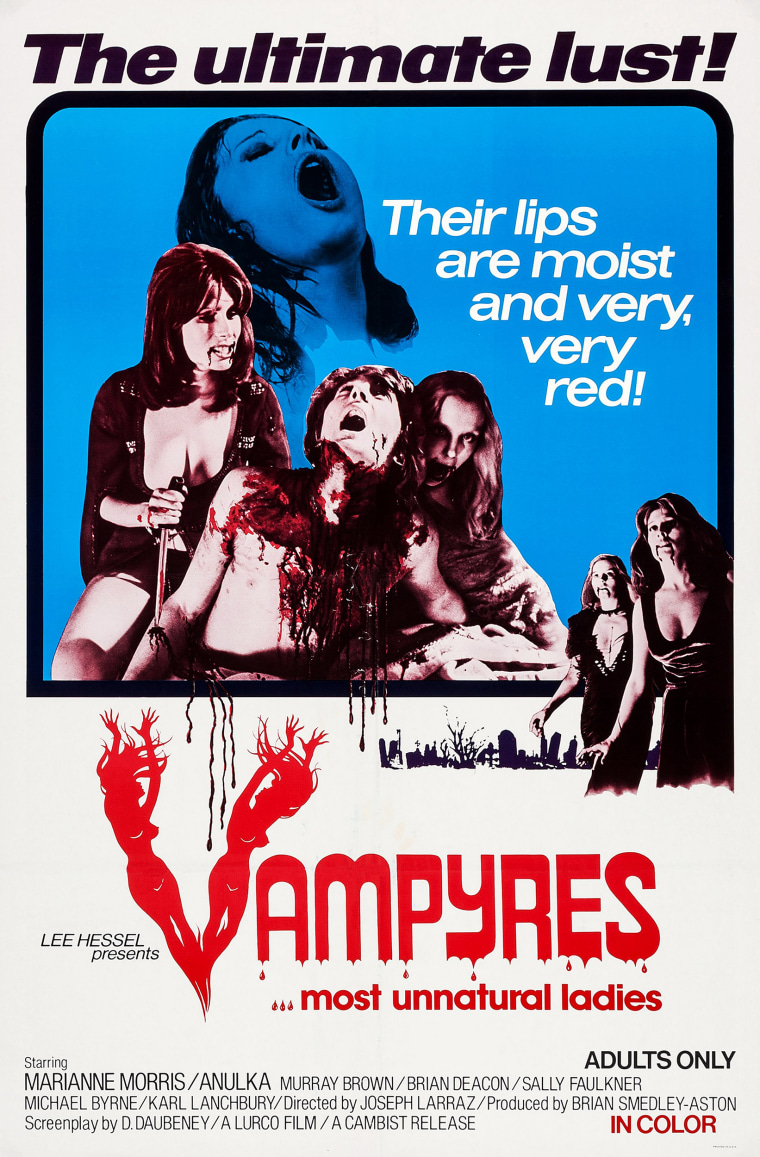
Oct. 30, 2021
By Elaina Patton
Sexual fluidity has been one of the hallmarks of vampiric portrayals throughout history. But lesbian vampires, in particular, have enjoyed a certain popularity. Beginning with early film adaptations of 19th-century novels to a present-day small-screen resurgence, the subgenre has proved to have serious staying power.
"I think part of it is just the appeal of vampires in general," said lesbian romance novelist Evelyn Dar, who runs a popular YouTube channel dedicated to lesbian entertainment. "They’re mysterious and dark. It’s taboo and sexy."
That appeal, however, was a double-edged sword for lesbian representation. For decades, and particularly during the subgenre’s heyday of the 1960s and ‘70s, vampire narratives were a dominant means of getting lesbianism on-screen. And the associations between sapphic love and bloodthirsty villains stuck.
“They were evil. They were sexually deviant. They almost always had to die,” Dar said of those popular depictions.

A movie poster for "Vampyres." Everett Collection
“It had to do with the status anxiety that straight men must have felt during those years, between the rise of the second wave of the women’s movement and after Stonewall. There was a kind of fear about lesbians that could be articulated in the vampire film,” said Andrea Weiss, a film professor at the City College of New York and author of “Vampires and Violets: Lesbians in Film.” “And also quell that anxiety by having the vampire be destroyed or become heterosexual at the end.”
The association between gay love and monstrosity proved to be pervasive in film and television, and this — in addition to the genre’s undeniable “camp” factor — has contributed to the reason horror has such a unique place in gay culture. On one hand, horror is unrivaled when it comes to queer visibility. On the other, it’s notoriously demonized and has perpetuated damaging stereotypes about gay people.
Early Hollywood loved its horror, but it wasn’t too keen on lesbians — or unorthodox women, for that matter. Hence, most of the big horror hits of the era were about monstrous men, like “Frankenstein,” “The Wolf Man” and, of course, “Dracula.” Hays Code restrictions, which attempted to police the morality of film productions, dictated that women were portrayed as borderline asexual innocents. That meant any discussion of sexuality, much less homosexuality, had to be done via subtext.
“Every time you turn on a TV show now, it’s almost mandatory that there’s a lesbian in it. It used to be the exact opposite: It was mandatory that there couldn’t be a lesbian in it,” Weiss said. “A large part of the appeal for lesbians was looking for these moments in overwhelmingly heterosexual cinema and repurposing them, reconditioning them for their own use.”
The first, most famous and perhaps only example of an early Hollywood lesbian vampire film is 1936's “Dracula’s Daughter,” Universal Pictures’ follow-up to its massive 1931 hit “Dracula.” In it, Dracula’s progeny, Countess Marya Zaleska, played by a stone-faced Gloria Holden, tries to free herself from her father’s curse but ultimately gives in to temptation, kidnapping a young woman and holding her hostage in Transylvania.
The film’s subtext is not about romance but rather an early on-screen example of the predatory homosexual. Much of that had to do with the studio’s bending to the will of censorship requirements, revising the script and making publicity efforts to demonize the relationship. But despite the watchful eye of censorship officials, Universal couldn’t control the monster it created, and the film became a reigning example of early cinema’s fascination with gay desire.
“It had to do with the status anxiety that straight men must have felt during those years, between the rise of the second wave of the women’s movement and after Stonewall. There was a kind of fear about lesbians that could be articulated in the vampire film,” said Andrea Weiss, a film professor at the City College of New York and author of “Vampires and Violets: Lesbians in Film.” “And also quell that anxiety by having the vampire be destroyed or become heterosexual at the end.”
The association between gay love and monstrosity proved to be pervasive in film and television, and this — in addition to the genre’s undeniable “camp” factor — has contributed to the reason horror has such a unique place in gay culture. On one hand, horror is unrivaled when it comes to queer visibility. On the other, it’s notoriously demonized and has perpetuated damaging stereotypes about gay people.
Early Hollywood loved its horror, but it wasn’t too keen on lesbians — or unorthodox women, for that matter. Hence, most of the big horror hits of the era were about monstrous men, like “Frankenstein,” “The Wolf Man” and, of course, “Dracula.” Hays Code restrictions, which attempted to police the morality of film productions, dictated that women were portrayed as borderline asexual innocents. That meant any discussion of sexuality, much less homosexuality, had to be done via subtext.
“Every time you turn on a TV show now, it’s almost mandatory that there’s a lesbian in it. It used to be the exact opposite: It was mandatory that there couldn’t be a lesbian in it,” Weiss said. “A large part of the appeal for lesbians was looking for these moments in overwhelmingly heterosexual cinema and repurposing them, reconditioning them for their own use.”
The first, most famous and perhaps only example of an early Hollywood lesbian vampire film is 1936's “Dracula’s Daughter,” Universal Pictures’ follow-up to its massive 1931 hit “Dracula.” In it, Dracula’s progeny, Countess Marya Zaleska, played by a stone-faced Gloria Holden, tries to free herself from her father’s curse but ultimately gives in to temptation, kidnapping a young woman and holding her hostage in Transylvania.
The film’s subtext is not about romance but rather an early on-screen example of the predatory homosexual. Much of that had to do with the studio’s bending to the will of censorship requirements, revising the script and making publicity efforts to demonize the relationship. But despite the watchful eye of censorship officials, Universal couldn’t control the monster it created, and the film became a reigning example of early cinema’s fascination with gay desire.
The golden era
“Dracula’s Daughter” and other coded takes on lesbianism lit a cultural fire that exploded in the ‘60s and ‘70s. As censorship and restrictions on nudity waned, lesbian vampires morphed from closeted predators to full-blown bloodthirsty seductresses.
The portrayal of their victims changed, as well. Men were either slavish henchmen or oafish prey. Women, however, were eyed as potential companions — more than just food, if not equals.
“One of the reasons people might like the lesbian vampire trope is it has a built-in good girl-bad girl trope. You see it a lot in lesfic, as well.” Dar said, referring to lesbian fiction. “It plays with that sense of danger that a lot of us like.”
“Who else are you going to be cool with climbing through a window at night while you’re sleeping? I’ll leave my window unlocked, but only for the vampire,” Dar, who recently produced a video about lesbian vampire films, said with a laugh.
Early films from this sapphic vampire golden era flirted with the good girl-bad girl eroticism that would come to dominate — and plague — the genre. One of the most famous is French director Roger Vadim’s “Blood and Roses” (1960). It’s a lavish portrayal of a woman who is driven mad by jealousy and her resulting obsession with a vampiric legend. It was one of the first adaptations of what would become the most popular source material for the genre: Sheridan Le Fanu’s novella “Carmilla.”
In the ‘70s, the industry’s enthusiasm for sex and violence reached a fever pitch. Exploitation films like 1974's “Vampyres” and 1973's “The Devil’s Plaything,” which had more in common with soft-core pornography than cinema, proliferated.
“You could get away with a certain kind of borderline pornography in a horror film that you couldn’t get away with in other films,” Weiss noted.
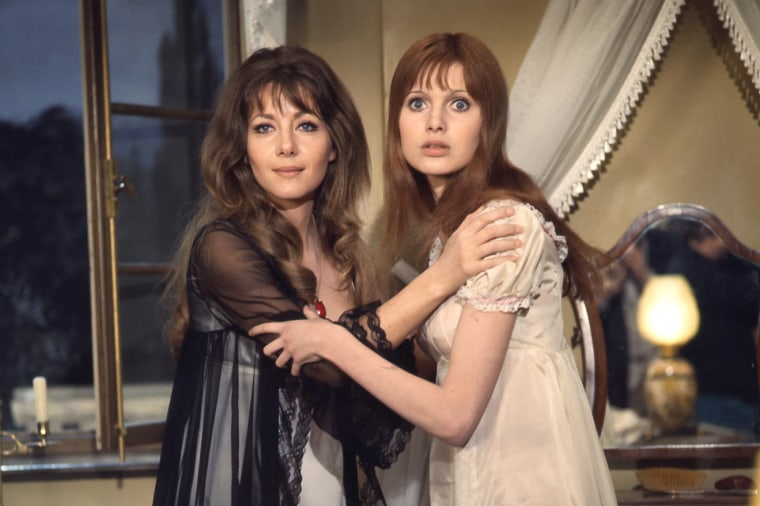
In the ‘70s, the industry’s enthusiasm for sex and violence reached a fever pitch. Exploitation films like 1974's “Vampyres” and 1973's “The Devil’s Plaything,” which had more in common with soft-core pornography than cinema, proliferated.
“You could get away with a certain kind of borderline pornography in a horror film that you couldn’t get away with in other films,” Weiss noted.

A still from "The Vampire Lovers."Hammer Films
“The Vampire Lovers” (1970) stands out as one of the more “humanizing” and romantic films of the era. It’s the first in a trilogy based on Le Fanu’s “Carmilla,” made by legendary production company Hammer Films. Although considered daring at the time for its depiction of sapphic seduction, the so-called Karnstein Trilogy, named after Le Fanu’s Countess Karnstein, feels misogynistic by contemporary standards. But “The Vampire Lovers,” widely regarded as the best of the three, definitely has its temptations — not least of which is star Ingrid Pitt.
Sexploitation titles, a subgenre of exploitation films, were geared toward men rather than lesbian audiences. The characters “acted as lesbians, but they were very much coded as heterosexual women so that they appealed to straight male audiences,” Weiss said.
Some international directors during this period managed to make films that had one foot in the realm of exploitation and the other in art house — and held more appeal for women. Spanish director Jesús Franco’s “Vampyros Lesbos” (1971) is a stylish film with an entrancing psychedelic score. The director’s favorite leading lady, Soledad Miranda, is cast as Dracula’s heir, who haunts the dreams of Linda, an American lawyer working in Istanbul. Where its more mainstream contemporaries drifted into the ridiculous or tawdry, “Vampyros Lesbos” has a transcendent, sophisticated quality that has been attributed to Franco’s expert eye.
Other cult favorites of the era that took a more elevated approach are “Daughters of Darkness” (1971), “The Blood Spattered Bride” (1972) and “Mary, Mary, Bloody Mary” (1975).
“The Vampire Lovers” (1970) stands out as one of the more “humanizing” and romantic films of the era. It’s the first in a trilogy based on Le Fanu’s “Carmilla,” made by legendary production company Hammer Films. Although considered daring at the time for its depiction of sapphic seduction, the so-called Karnstein Trilogy, named after Le Fanu’s Countess Karnstein, feels misogynistic by contemporary standards. But “The Vampire Lovers,” widely regarded as the best of the three, definitely has its temptations — not least of which is star Ingrid Pitt.
Sexploitation titles, a subgenre of exploitation films, were geared toward men rather than lesbian audiences. The characters “acted as lesbians, but they were very much coded as heterosexual women so that they appealed to straight male audiences,” Weiss said.
Some international directors during this period managed to make films that had one foot in the realm of exploitation and the other in art house — and held more appeal for women. Spanish director Jesús Franco’s “Vampyros Lesbos” (1971) is a stylish film with an entrancing psychedelic score. The director’s favorite leading lady, Soledad Miranda, is cast as Dracula’s heir, who haunts the dreams of Linda, an American lawyer working in Istanbul. Where its more mainstream contemporaries drifted into the ridiculous or tawdry, “Vampyros Lesbos” has a transcendent, sophisticated quality that has been attributed to Franco’s expert eye.
Other cult favorites of the era that took a more elevated approach are “Daughters of Darkness” (1971), “The Blood Spattered Bride” (1972) and “Mary, Mary, Bloody Mary” (1975).
Banished to the fringes
Things cooled off considerably in the decades following the lesbian vampire boom of the ‘60s and ‘70s. Big-franchise horror dominated the landscape, and lesbian vampires were largely banished to the fringes, most often appearing in adult films. But, occasionally, they grabbed the attention of a more artful eye.
Perhaps the most widely beloved lesbian vampire movie came at the beginning of this transition: “The Hunger” (1983). Though some debate its merit as a standalone film, it features one of cinema’s most stylish and talented love triangles: Catherine Deneuve, Susan Sarandon and David Bowie. It introduced a new kind of vampiric decadence with its over-the-top fashions and exquisitely cool cast, the influence of which can be seen in later films like “Interview With the Vampire” and “Only Lovers Left Alive.” But it’s best known for the iconic sex scene between Deneuve and Sarandon.
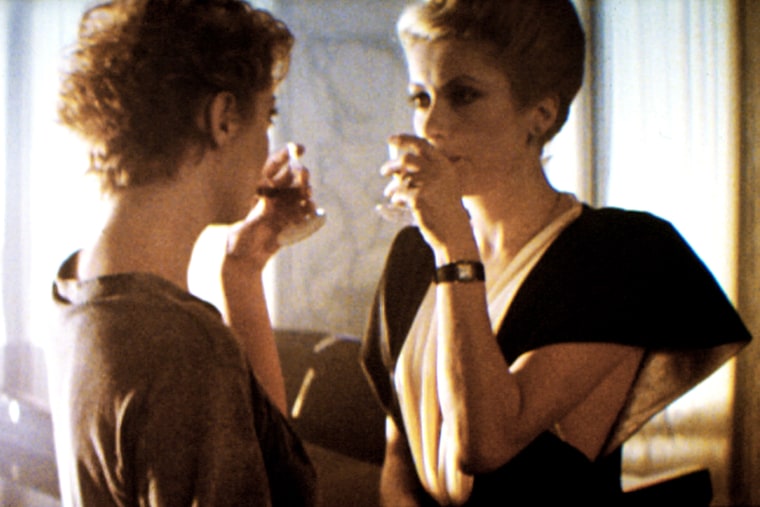
Susan Sarandon and Catherine Deneuve in "The Hunger."
©MGM / Courtesy Everett Collection
That sex scene became a coveted jewel for lesbian audiences during the repressive ‘80s. When Dar made a video about classic lesbian films that included “The Hunger,” she said she was reminded of the significance of the film, which also happens to be her favorite of the genre.
“I had a lot of people that were older than me saying, ‘I watched that movie so many times because that was all we really had,’” she said.
Weiss also recalled the fervor around “The Hunger,” like “Daughters of Darkness” before it: “In a way, those were spoofs on the lesbian vampire iconography, done in the art house tradition. They still played with the representation that appealed to men, but they also appealed to women. They were much more ambiguous about the message embodied in the lesbian vampire figure.”
A lesser-known but equally notable film is Michael Almereyda's “Nadja” (1994). It combines surreal, black-and-white visuals with plenty of existential angst. Its impressive cast includes Peter Fonda, Martin Donovan and Elina Löwensohn — as well as executive producer David Lynch, who makes a cameo as a hapless morgue attendant. Even without the lesbian vampires, “Nadja” would be essential ‘90s viewing.
A feminist makeover
In the past few decades, vampires have undergone a massive cultural makeover, becoming more inclusive and socially aware. The late aughts offered one of the more complex vampire films ever made: the Swedish genderqueer romantic horror “Let the Right One In.” And, in more mainstream entertainment, lesbian vampires got a feminist update.
Beginning in the late 2000s, Alan Ball’s wildly popular HBO series “True Blood” (2008-2014) acted as a kind of precursor to the progressive and campy mainstream content that’s now taken over.
That sex scene became a coveted jewel for lesbian audiences during the repressive ‘80s. When Dar made a video about classic lesbian films that included “The Hunger,” she said she was reminded of the significance of the film, which also happens to be her favorite of the genre.
“I had a lot of people that were older than me saying, ‘I watched that movie so many times because that was all we really had,’” she said.
Weiss also recalled the fervor around “The Hunger,” like “Daughters of Darkness” before it: “In a way, those were spoofs on the lesbian vampire iconography, done in the art house tradition. They still played with the representation that appealed to men, but they also appealed to women. They were much more ambiguous about the message embodied in the lesbian vampire figure.”
A lesser-known but equally notable film is Michael Almereyda's “Nadja” (1994). It combines surreal, black-and-white visuals with plenty of existential angst. Its impressive cast includes Peter Fonda, Martin Donovan and Elina Löwensohn — as well as executive producer David Lynch, who makes a cameo as a hapless morgue attendant. Even without the lesbian vampires, “Nadja” would be essential ‘90s viewing.
A feminist makeover
In the past few decades, vampires have undergone a massive cultural makeover, becoming more inclusive and socially aware. The late aughts offered one of the more complex vampire films ever made: the Swedish genderqueer romantic horror “Let the Right One In.” And, in more mainstream entertainment, lesbian vampires got a feminist update.
Beginning in the late 2000s, Alan Ball’s wildly popular HBO series “True Blood” (2008-2014) acted as a kind of precursor to the progressive and campy mainstream content that’s now taken over.
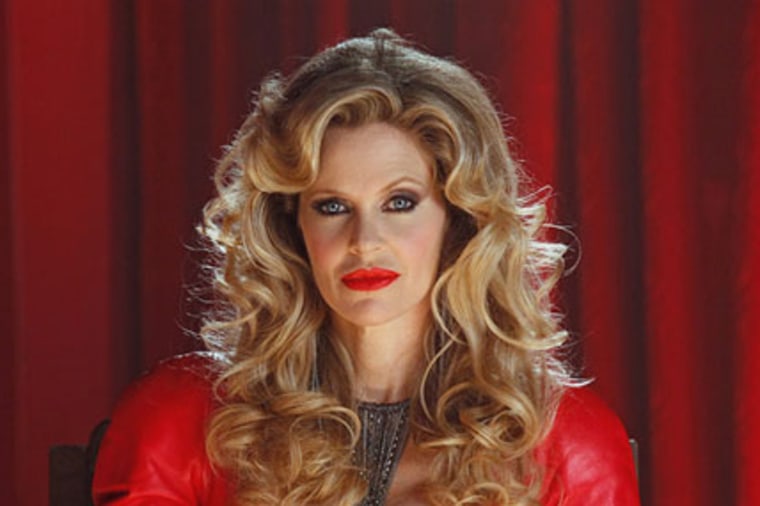
Pam from "True Blood."HBO
“True Blood” has it all: vampires, fairies, witches, werepanthers and, of course, Pam. With biting one-liners and a withering stare, Pam mercilessly rules over small-town Louisiana and the vampire nightclub Fangtasia. Thanks to her character and a host of other queer storylines, the series received high marks for representation and won multiple awards from LGBTQ media advocacy organization GLAAD during its star-studded tenure. It was also one of the first productions to feature a Black lesbian vampire in a central role.
More recently, there’s been a slew of offerings characterized by progressive values and questionable quality. The woman-driven Canadian web series “Carmilla” (2014-2016) generated enough interest to be adapted into a feature-length film.
“It’s campy, it’s cheesy, but I love the fact that they reappropriated the lesbian vampire so that it stopped being about this evil predator for the titillation of men,” Dar said. “It’s still sexy, still titillating, but just in a different way.”
“True Blood” has it all: vampires, fairies, witches, werepanthers and, of course, Pam. With biting one-liners and a withering stare, Pam mercilessly rules over small-town Louisiana and the vampire nightclub Fangtasia. Thanks to her character and a host of other queer storylines, the series received high marks for representation and won multiple awards from LGBTQ media advocacy organization GLAAD during its star-studded tenure. It was also one of the first productions to feature a Black lesbian vampire in a central role.
More recently, there’s been a slew of offerings characterized by progressive values and questionable quality. The woman-driven Canadian web series “Carmilla” (2014-2016) generated enough interest to be adapted into a feature-length film.
“It’s campy, it’s cheesy, but I love the fact that they reappropriated the lesbian vampire so that it stopped being about this evil predator for the titillation of men,” Dar said. “It’s still sexy, still titillating, but just in a different way.”
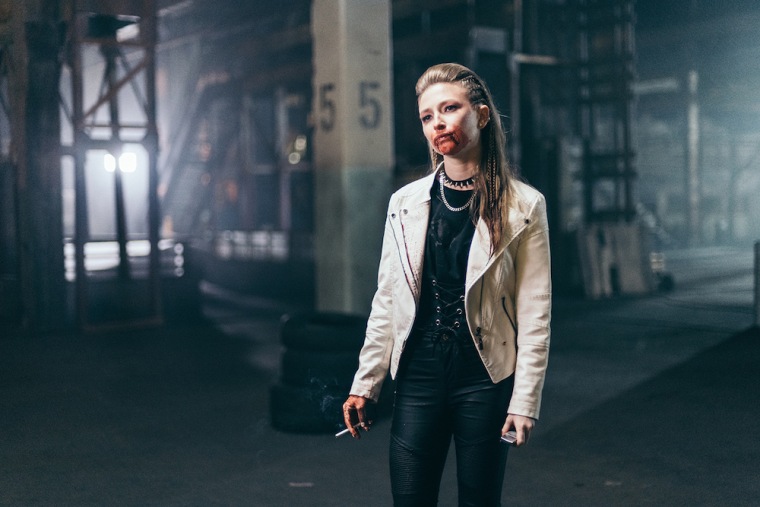
A still from "Bit."
Nick Cafritz / Provocator
A growing selection of young adult content has also helped renew interest in the genre. In the feminist revenge thriller “Bit” (2019), the main character, played by transgender actress Nicole Maines (“Supergirl”), moves from Oregon to Los Angeles and connects with a group of queer feminist vampires who target predatory men. And Netflix’s upcoming teen vampire series “First Kill” is generating a fair amount of buzz among lesbian audiences.
While the messaging of the new crop of lesbian-inclusive vampire content is more progressive, many of the newer titles lack the rich cinematic history of the earlier fare — even if the classics did have problematic themes.
“Eventually, we have to stop being happy that things just exist. Things need to actually be good,” Dar said. “I don’t think the appetite has been satisfied. If I’m saying my favorite vampire film was made in the 1980s and it’s 2021, there’s still a lot of room there.”
A growing selection of young adult content has also helped renew interest in the genre. In the feminist revenge thriller “Bit” (2019), the main character, played by transgender actress Nicole Maines (“Supergirl”), moves from Oregon to Los Angeles and connects with a group of queer feminist vampires who target predatory men. And Netflix’s upcoming teen vampire series “First Kill” is generating a fair amount of buzz among lesbian audiences.
While the messaging of the new crop of lesbian-inclusive vampire content is more progressive, many of the newer titles lack the rich cinematic history of the earlier fare — even if the classics did have problematic themes.
“Eventually, we have to stop being happy that things just exist. Things need to actually be good,” Dar said. “I don’t think the appetite has been satisfied. If I’m saying my favorite vampire film was made in the 1980s and it’s 2021, there’s still a lot of room there.”
No comments:
Post a Comment